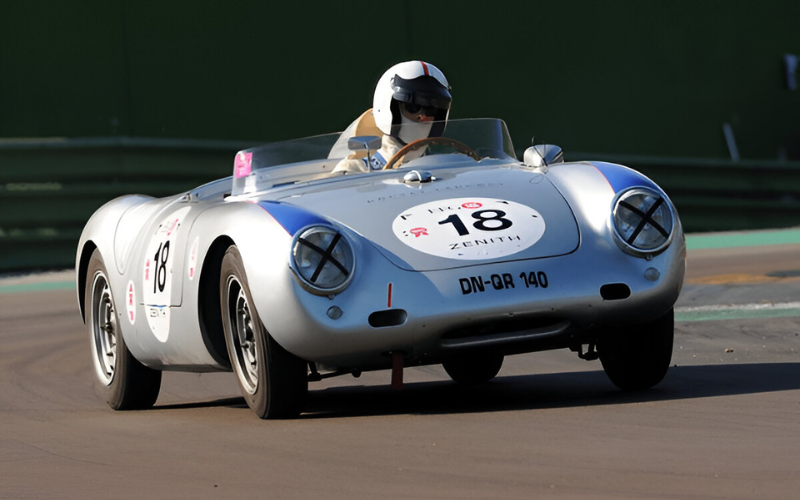Introduction
The Porsche RS 550 Spyder is one of the most legendary sports cars ever built. Born in the 1950s as a lightweight racing machine, it quickly earned a reputation for speed, agility, and style far beyond its size. More than just a race car, the 550 Spyder became a cultural icon, remembered both for its engineering brilliance and its place in automotive history.
Origins of the Porsche RS 550 Spyder
The Porsche RS 550 Spyder was developed in the early 1950s with a clear purpose: to compete on the world’s toughest race tracks. Porsche’s engineers set out to build a car that could challenge much larger and more powerful rivals, relying on clever design rather than brute force.
How Porsche developed the RS 550 as a purpose-built racing car
Introduced in 1953, the 550 Spyder was Porsche’s first true factory-built race car, not just a modified road model. Its creators designed every element with competition in mind, from the mid-engine layout to the compact proportions that gave it a perfect balance between power and handling. This was the car that marked Porsche’s entry into serious international motorsport.
The inspiration behind its lightweight design and engineering
Weight reduction was at the heart of the RS 550’s philosophy. With a tubular steel frame and an aluminum body, the car weighed just over 500 kilograms (about 1,200 pounds). Combined with a small but highly tuned 1.5-liter four-cylinder engine, the Spyder could keep pace with much larger cars. This focus on lightweight engineering set the foundation for Porsche’s racing identity for decades to come.
Racing Heritage and Historic Victories
From the moment it appeared on the grid, the Porsche RS 550 Spyder proved it was far more than just a lightweight experiment. Its racing record in the 1950s quickly established the car as a serious competitor on the global stage.
Key races and championships won by the 550 Spyder
The 550 Spyder made its competitive debut at the Nürburgring in 1953 and immediately caught attention. In the years that followed, it claimed victories and podium finishes in some of the most demanding endurance races of the era, including the 24 Hours of Le Mans, the Carrera Panamericana in Mexico, and the Targa Florio in Sicily. Its ability to outperform larger, more powerful cars in endurance events gave Porsche international recognition and respect in motorsport.
Its reputation among professional drivers in the 1950s
Professional drivers admired the 550 Spyder for its sharp handling, agility, and reliability. Unlike many heavy and temperamental race cars of its time, the Spyder was predictable and responsive, making it especially effective on twisty circuits. This earned it the nickname “giant killer,” since it often outpaced rivals with far more horsepower. Its success also helped attract a new generation of drivers to Porsche, laying the groundwork for the company’s long-standing motorsport legacy.
Design and Engineering Excellence
The Porsche RS 550 Spyder stood out not only for its race results but also for its engineering ingenuity and timeless design. Every detail was built with performance in mind, yet the car carried a distinct elegance that made it instantly recognizable.
Signature styling elements that set the 550 Spyder apart
The 550 Spyder featured a low, sleek profile with clean aerodynamic lines. Its compact proportions and minimalist design were both functional and beautiful, giving the car an unmistakable silhouette on the track. The open cockpit, exposed wheels, and purposeful stance reflected Porsche’s focus on simplicity, lightness, and efficiency — traits that would later define the brand’s sports cars.
Technical innovations that made it competitive on the track
Lightweight chassis and aerodynamics
The car’s tubular steel frame kept weight to a minimum, while its aluminum body ensured durability without sacrificing speed. Its aerodynamic shape reduced drag and improved stability at high speeds, which was crucial for endurance racing. Together, these features made the 550 Spyder remarkably nimble and able to compete with much larger cars.
Engine performance and handling
At the heart of the 550 Spyder was the advanced 1.5-liter “Fuhrmann” engine, a four-cylinder powerhouse designed specifically for racing. Despite its modest size, the engine delivered impressive power thanks to dual overhead camshafts and a sophisticated carburetor system. Paired with the car’s mid-engine layout, this gave the Spyder precise handling and excellent balance, making it a favorite among skilled drivers who valued control as much as speed.
The Porsche RS 550 Spyder in Popular Culture
Beyond its racing triumphs, the Porsche RS 550 Spyder carved out a unique place in popular culture. Its combination of beauty, speed, and rarity made it a car that transcended motorsport, capturing the imagination of enthusiasts and the general public alike.
How the 550 Spyder became a cultural icon beyond racing
The 550 Spyder’s sleek design and underdog success story helped it stand out in the 1950s, but its fame spread far beyond racetracks. It became a symbol of freedom, individuality, and daring — values often associated with sports cars of the era. Over time, its image appeared in magazines, films, and automotive history books, cementing its reputation as more than just a machine: it became a legend.
Famous ownership stories that boosted its legend
One of the most enduring aspects of the 550 Spyder’s cultural identity comes from its famous owners. Actor James Dean purchased one in 1955, nicknaming it “Little Bastard.” His tragic death while driving the car gave the 550 Spyder an almost mythical status, forever linking it to Hollywood history. Beyond Dean, a handful of racers, collectors, and celebrities also prized the Spyder for its rarity and performance, adding to its aura of exclusivity and intrigue.
Collector Value and Rarity Today
The Porsche RS 550 Spyder is among the most prized classic cars in the world. With fewer than 100 examples ever produced, each surviving model is a rare piece of motorsport history, making it highly desirable for collectors.
Why the RS 550 Spyder is one of the most sought-after classic Porsches
Collectors value the 550 Spyder not only for its scarcity but also for what it represents — the beginning of Porsche’s dominance in racing. Owning one is like holding the foundation stone of the brand’s performance legacy. Its lightweight engineering, proven track record, and cultural significance make it a centerpiece in any serious collection of vintage sports cars.
Record-breaking auction prices and market trends
When a 550 Spyder comes up for auction, it often makes headlines. Well-preserved or historically significant examples have fetched multi-million-dollar prices, reflecting both their rarity and timeless appeal. In recent years, auction values have steadily climbed as demand from collectors continues to outpace supply. The market trend suggests that the RS 550 Spyder will remain one of the most valuable classic Porsches for decades to come.
Driving Experience and Legacy
The Porsche RS 550 Spyder was designed first and foremost as a race car, and driving one remains a unique experience even today. Its character combines raw performance with mechanical purity, offering a direct connection between driver, machine, and road.
What it’s like to drive a 550 Spyder
Behind the wheel, the 550 Spyder feels incredibly light and responsive. The mid-engine layout gives it excellent balance, allowing drivers to carry speed through corners with confidence. With minimal driver aids and no unnecessary features, it demands focus and skill, rewarding precision with thrilling agility. Many who have experienced it describe the car as playful, alive, and unlike anything built in modern times.
Its influence on future Porsche sports cars
The legacy of the 550 Spyder can be seen in nearly every Porsche that followed. Its mid-engine design laid the groundwork for later race cars like the 718 and modern-day 918 Spyder, while its philosophy of lightweight construction and driver-centered performance became central to Porsche’s identity. Even today, the spirit of the 550 Spyder continues to inspire engineers and enthusiasts alike, reminding the world that true performance comes from balance, not just brute power.
Conclusion
The Porsche RS 550 Spyder remains one of the most influential sports cars ever built. Born from Porsche’s determination to prove itself on the racetrack, it combined lightweight engineering, agile handling, and innovative design in a way that set new standards for performance. Its racing triumphs, cultural impact, and lasting influence on Porsche’s identity have secured its place as a true legend.
Today, whether admired for its history, collected as a rare treasure, or remembered as a cultural icon, the 550 Spyder continues to symbolize the essence of Porsche — precision, passion, and the pursuit of driving perfection.
FAQ
Q1: How many Porsche RS 550 Spyders were made?
Porsche built fewer than 100 RS 550 Spyders between 1953 and 1956. This limited production is one of the main reasons why the car is so rare and highly valued today.
Q2: What engine powered the Porsche 550 Spyder?
The 550 Spyder was equipped with a 1.5-liter flat-four engine known as the “Fuhrmann engine.” Despite its small size, it featured advanced engineering for the time, including dual overhead camshafts, and delivered strong performance on the track.
Q3: Why is the Porsche 550 Spyder so valuable today?
Its value comes from a combination of factors: very limited production numbers, historic racing success, technical innovation, and cultural significance. Collectors see it as one of the most important cars in Porsche’s history.
Q4: What is the connection between the Porsche 550 Spyder and James Dean?
Actor James Dean famously owned a 550 Spyder, which he nicknamed “Little Bastard.” He tragically died in a crash while driving the car in 1955, which gave the model a lasting association with his legacy and contributed to its mythical status.

